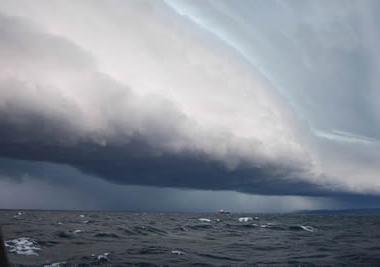Rain ... Snow ... A piercing wind ... The scorching sun ... These manifestations of the weather have been familiar to all of us since childhood. But even after diligently studying geography at school, we are still sometimes surprised by sudden changes in temperature and unusual natural disasters. Climatic leaps are invariably associated with atmospheric fronts. They form the daily weather and determine the boundaries of the seasons.
Atmospheric front
The word "front" (from the Latin "frontis" - forehead, front side) implies a thin line between something. It can take place, for example, between different areas of hostilities: areas of concentration of enemy forces and a friendly army. If we use the phrase "atmospheric front," we mean the boundary in the air, a certain boundary in the atmosphere. What exactly does he share, and how does this affect us?
Mother Nature has formed a favorable climate in which a person can exist, multiply and develop. We live in the troposphere, the lower part of the atmosphere, which not only gives us oxygen, but also is in constant motion. Some volumetric
air masses in it interact from time to time. In the middle of each of these formations there are small foci of microclimate, which differ in properties, but are generally homogeneous, while maintaining a stable temperature and humidity. Masses move above the Earth's surface, meet and even collide. But never mix. The border between them is called the atmospheric front.
Main types
The bandwidth between air masses of the same properties reaches tens, sometimes hundreds of kilometers. This is an atmospheric front where air pressure surges always occur, cloudiness and temperature change. That is, it is precisely in these areas that one can observe how the cold rain is replacing the hot sun and vice versa. If very close, practically homogeneous masses come into contact, the atmospheric front does not arise. As a result, the weather does not change.
There are several
types of atmospheric fronts. They were formed on the basis of
climatic zones, the main indicators of which remain constant.
- Arctic. Separates cold arctic air from temperate.
- Polar. Located between temperate and tropical air masses.
- Tropical. This is the boundary between the tropical and equatorial zones.
In the case of complete immobility of the air masses, the front would take a horizontal position. In this case, a layer of cold air would always be below, and warm - above. But as a result of constant cyclicity, it is located at an angle to the surface of the earth.
Cold front
Whether the weather will change in our region and what it will be - all this will be demonstrated by a map of atmospheric fronts. It clearly shows that the warm front is always inclined in the direction in which it is moving, the cold front - in the opposite. When the latter moves into a high-temperature zone, and penetrates into it with a kind of wedge, pushing upward, a cooling snap occurs in this territory. Warm masses gradually cool down, moisture is released from them - this is how clouds and clouds form.

The first sign of a cold front approaching is cumulus rain formation that appears on the horizon. At the same time, the wind blows in gusts, sharply changing direction. The wall of heavy rain collapses suddenly. The sky is gloomy, lightning cut through it, thunder booms, sometimes hail. Bad weather lasts no more than two hours, after which rainfall stops. The air temperature drops, sometimes immediately by 5-10 degrees, since the space of the atmosphere is completely occupied by the cold front, which displaced the air warmed by the sun.
Warm front
It is formed when a zone of high positive temperature "leaks" onto a cold mass. It is as if she glides over her, gradually rising. The weather changes smoothly, without unforeseen sudden jumps and drops. Cirrus clouds are the first sign that an atmospheric front is approaching, in the center of which a rather high air temperature. No wind has been observed yet. If he is, then his breaths are always pleasant and light.
Gradually, the clouds melt, and a continuous white veil of small layered formations forms in the sky, which move through the clear blue sky. After some time, they pile up in a heap: a dense layer drops below, the wind rises, drizzle rain or light snow falls. Precipitation intensifies, it lasts several hours, sometimes days, after which warming sets in. Good weather does not last long. The atmospheric front, in which the temperature is low, catches up with the heat zone, as it moves faster and faster.
Cyclone
The air on the surface of the earth is unevenly distributed. As a result of this, high and low pressure zones are formed. In the first region, air is in abundance, in the second - in lack. From the high-pressure zone, it flows outward, as if overflowing over the edge of the glass, and fills the formed "holes" in the area where the pressure is low. We call this natural phenomenon the wind.
The low pressure section is the cyclone. It has the shape of a vortex. See how water flows from the sink - it forms a funnel. The same principle shows us the weather. The cyclone is the same funnel in the sink, only turned upside down. In its center is a low-pressure pole, which draws air from all sides and rises upward, moreover, it twists clockwise in the
southern hemisphere and against it in the northern one. Inside the cyclone, it is cloudy, because together with the wind it “sucks” clouds into itself. They slide down the hill from those zones where the pressure is high.
Anticyclone
It works exactly the opposite. In the center is high pressure, there is a lot of air there, so it spreads in all directions, as if cream squeezed out of a confectionery bag. Streams are twisted clockwise in the northern hemisphere, against - in the southern. Here is another example: if you pull a carbonated drink into a tube and then release it, it invariably drains into a glass. A similar phenomenon occurs in an anticyclone. Only with the help of air and globally.

The weather in the anticyclone is usually clear, as high pressure displaces the clouds from this section. At the same time, it is always very hot in summer: there are no barriers in the form of clouds preventing the sun from warming the air. In winter, the opposite is true. The sun is low enough, but it can’t warm the air: there are no clouds, and therefore nothing retains heat. As a result, in winter, when the anticyclone arrives, the weather is clear, but frosty. By the way, studying atmospheric fronts, cyclones and anticyclones, their movements, modifications and transformation, weather forecasters make a weather forecast for a particular region.
What is the day ahead preparing for us?
The hardest part, weather forecasters say, is to anticipate the weather for the next three days. That is, after collecting all the necessary information, you need to quickly process it, taking into account all the vagaries of atmospheric fronts, changes in cyclones and anticyclones. And only by comparing the data, we can conclude.
Weather forecasts are as follows:
- Short-term - for a maximum of three days.
- Medium-term - up to ten days.
- Long-term weather forecast - for a month or season.
The first two types are the synoptic's solution of the equations of thermodynamics and dynamics, which describe the state of the atmosphere. To do this, experts analyze the possibility of changing the direction of the wind, precipitation, the expected jumps in pressure and humidity. A long-term weather forecast is never completely accurate. Even with the latest equipment, weather forecasters cannot foresee all the surprises prepared by nature. But in any case it is necessary to compile it, since such a forecast refers to the expected monthly or seasonal weather anomalies.